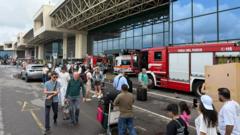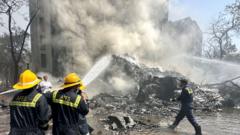When passengers boarded the IndiGo aircraft from New Delhi to Srinagar, few anticipated the chaos that was about to unfold. As the flight ascended, a powerful hailstorm abruptly struck, causing the plane to jolt violently. Sheikh Samiullah, a 33-year-old logistics CEO, recalls the sheer panic enveloping the cabin: “They were calling their gods, we were calling our gods,” he said, describing how passengers erupted in cries of desperation.
For five to six terrifying minutes, the airplane felt as though it was in a life-threatening descent, swaying and plunging amidst a chorus of frantic prayers in both Hindi and Arabic. Some passengers even recorded the incident on their phones, capturing their disbelief as they braced for impact.
Yet, against all odds, after twenty agonizing minutes of turbulence, the aircraft managed to touch down safely in Srinagar. Upon deplaning, the traumatized passengers discovered significant damage to the plane’s nose, a grim reminder of the brutal hail they had just survived.
In a statement, IndiGo confirmed the flight faced a “sudden hailstorm,” asserting that the crew followed established safety protocols throughout the ordeal. The Federal Aviation Administration warns that hail, often invisible until too late, poses a major risk during thunderstorms, frequently resulting in engines stalling or causing other severe aircraft malfunctions.
The importance of weather radar in avoiding such dangers is underscored by experts, as passenger aircraft can sustain critical damage from smaller hailstones. This incident echoes a similar tragedy last year when intense turbulence led to a fatality during a Singapore Airlines flight.
The resilience of the passengers aboard this IndiGo flight serves as a testament to human bravery in the face of nature's fury, reminding us of both the power and unpredictability of weather in air travel.
For five to six terrifying minutes, the airplane felt as though it was in a life-threatening descent, swaying and plunging amidst a chorus of frantic prayers in both Hindi and Arabic. Some passengers even recorded the incident on their phones, capturing their disbelief as they braced for impact.
Yet, against all odds, after twenty agonizing minutes of turbulence, the aircraft managed to touch down safely in Srinagar. Upon deplaning, the traumatized passengers discovered significant damage to the plane’s nose, a grim reminder of the brutal hail they had just survived.
In a statement, IndiGo confirmed the flight faced a “sudden hailstorm,” asserting that the crew followed established safety protocols throughout the ordeal. The Federal Aviation Administration warns that hail, often invisible until too late, poses a major risk during thunderstorms, frequently resulting in engines stalling or causing other severe aircraft malfunctions.
The importance of weather radar in avoiding such dangers is underscored by experts, as passenger aircraft can sustain critical damage from smaller hailstones. This incident echoes a similar tragedy last year when intense turbulence led to a fatality during a Singapore Airlines flight.
The resilience of the passengers aboard this IndiGo flight serves as a testament to human bravery in the face of nature's fury, reminding us of both the power and unpredictability of weather in air travel.






















